Experience from Chiloé island, in the south of Chile, demonstrates how even small grants can boost small business and tourism in a way that helps both communities and shorebird conservation.
By: James Lowen
Encouraged by wildlife local guide Moises Barrientos, a young Chilean girl peers through a telescope at a shorebird flock resting on the “Santuario de la Naturaleza humedales del río Maullín” in Los Lagos Region. ‘Zarapitos de pico recto!’, she exclaims, recognising the Hudsonian Godwits (Limosa haemastica) from the information board brightening the circular observation hide where she is birdwatching. Her family is on a weekend visit from the nearby city of Puerto Montt. Later they will explore the bird-festooned Río Quenuir by boat, will lunch at a local restaurant and may enjoy a spot of retail therapy at a local craft shop. Their mini-holiday results from a perfect marriage between conservation and the local economy – a tourism-based relationship that would not have been possible without ‘microfunding’.
As the word suggests, microfunds comprise small loans or grants to support small businesses – in this instance, grants to the tune between five hundred and a thousand US dollars. This may not sound like much, but in the rural communities of the Chiloé Island a little can go a very long way.
For migratory shorebirds such as the Hudsonian Godwit, such financing is proving a big deal. This long-billed, long-legged species undertakes an epic journey over 9,000 kilometers along the Pacific Flyway of the Americas. Safe and healthy sites to spend the austral winter are critical for its survival. One such site, in the Los Lagos region of Chile, is the Humedales Orientales de Chiloé Western Hemisphere Shorebird Reserve Network (WHSRN) Site. This is a Site of Hemispheric Importance for shorebirds, hosting wintering grounds for at least 27% of the global population of Hudsonian Godwit (21,000 birds) and 99% of the Pacific Coast population of Whimbrel (Numenius phaeopus).
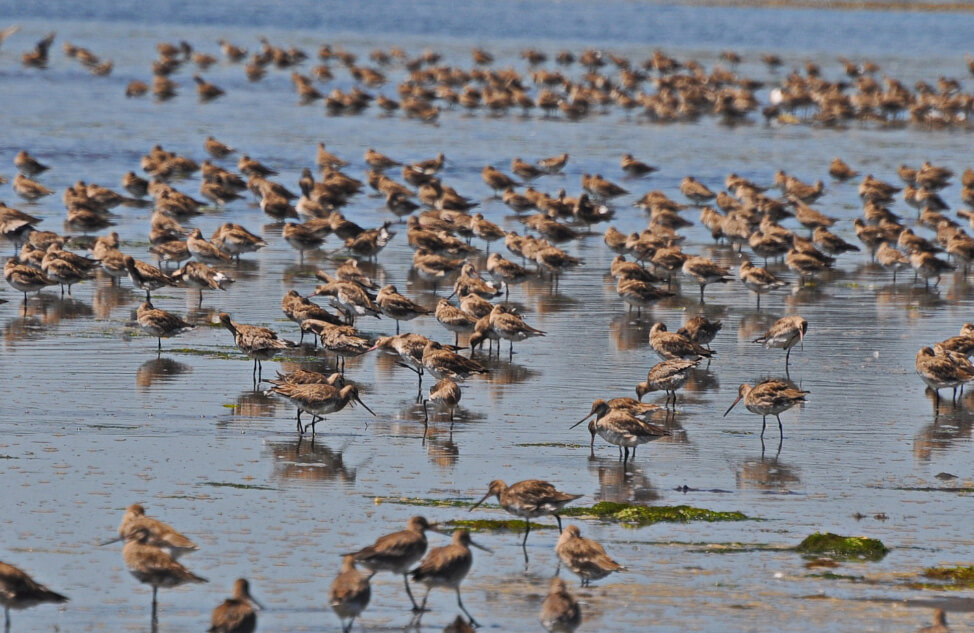
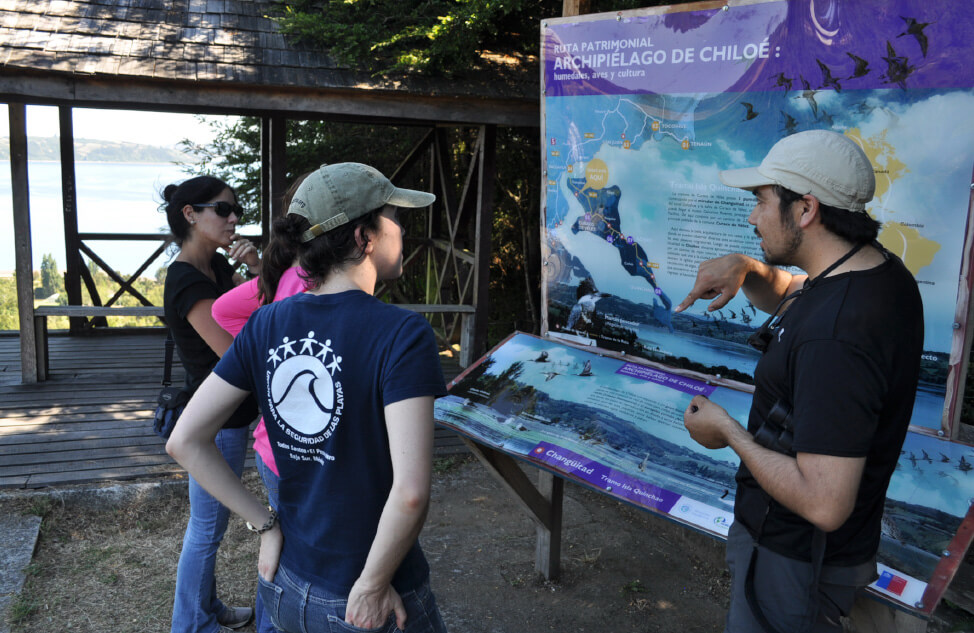
Left: Chiloé is Hudsonian Godwits´ paradise. Photo: Diego Luna Quevedo. Right: The heritage route “Chiloé: wetlands, birds and culture” serves as a framework for tourism and local entrepreneurship. Photo: Diego Luna Quevedo
These wetlands are not only important for birds, as Claudio Delgado of the Chilean nongovernmental organization, Fundación Conservación Marina, explains. “They are also important to the well-being of human communities,” he says, “providing people with food and recreation as well as contributing to local identity”. This juxtaposition of avian and anthropogenic needs has been driving the innovative approach to conservation in the region.
Launched in 2010, the Migratory Shorebird Conservation Plan of Chiloé integrates birds and people at its heart. Its seven primary goals include one to promote initiatives that integrate conservation and local development. It is doing this through kickstarting ecotourism, thereby addressing what Manomet’s Diego Luna Quevedo, Senior Specialist on Policy and Governance considers one of the main challenges for conservation processes, namely “answering the question: what do I gain from conservation?”
Ecotourism, Claudio explains, can provide “local families with a direct, tangible benefit from conservation”. Integrating shorebirds – and the wetlands in which they live – into local livelihoods through birdwatching and ecotourism provides a clear incentive for communities to protect species and ecosystems. In 2014, the project found that several families living near key Chiloé wetlands were interested in developing ecotourism offerings – but were reluctant to take financial risks.
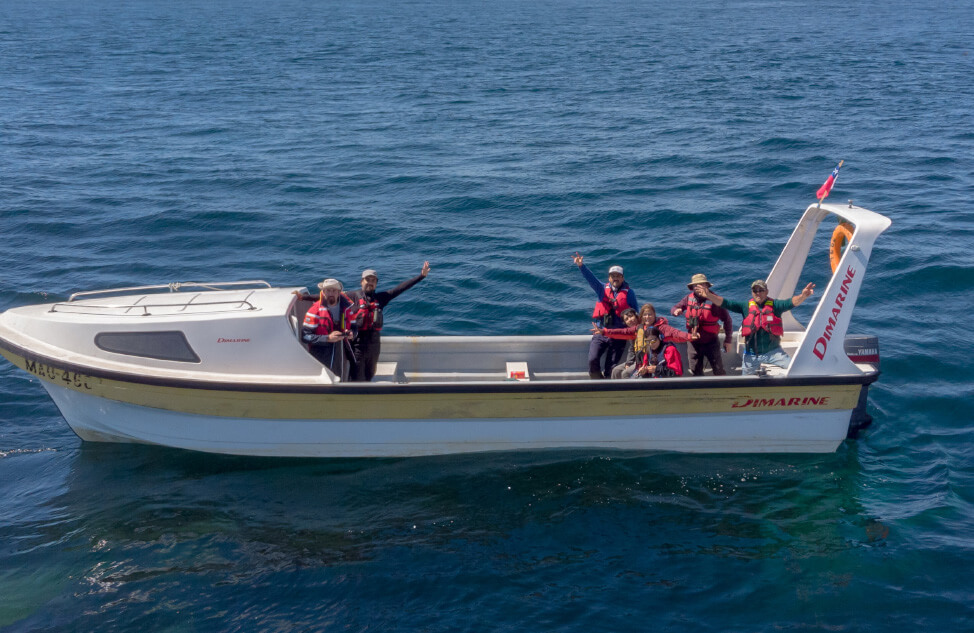
Moisés Barrientos, from fisherman to tourism entrepreneur with the support of the microfunds. Photo: José Cárdenas Vejar.
Through funding from the David and Lucile Packard Foundation, an opportunity to defray those risks arose. “We realised that a small financial boost could make a difference in the initial stage of potential ventures.” From 2014 to 2023, following trust-building discussions over mate (a hot drink) and pan amasado (a speciality flatbread), 17 local entrepreneurs received small grants to help them get shorebird-friendly ideas off the ground.
Funding covered a range of activities. The common denominator, Diego explains, “was that everyone was interested in shorebirds and wanted to incorporate them into their business somehow”. A small restaurant named after the visiting shorebirds, Fogón los Zarapitos, expanded its premises to include an area from which diners could simultaneously eat and watch three thousand godwits through provided spotting scopes. Customers have been flooding in.
A small grant helped a group of artisans establish a room where they could sell their work while conducting environmental education. Luis Neira, director of the Agrupación de Artesanos de Curaco de Vélez, praises microfunding for laying the ground for simultaneously “significantly increasing our sales and enabling us to strengthen [opportunities for] tourists and appreciation of the importance of conserving our priority sites.”
Some craftworkers bought materials needed to create a collection of felt birds – specifically local shorebirds. One, Mirella Oyarzún, told Diego that “the help came at precisely the right time – when I didn’t have enough money to purchase supplies”. Thanks to the microfund, Mirella produced 25 items that were all bought by participants at the 2017 South American Bird Fair, held in the Chilean city of Puerto Varas. Today, Diego says proudly, Mirella continues to sell felt birds successfully through a local shop.
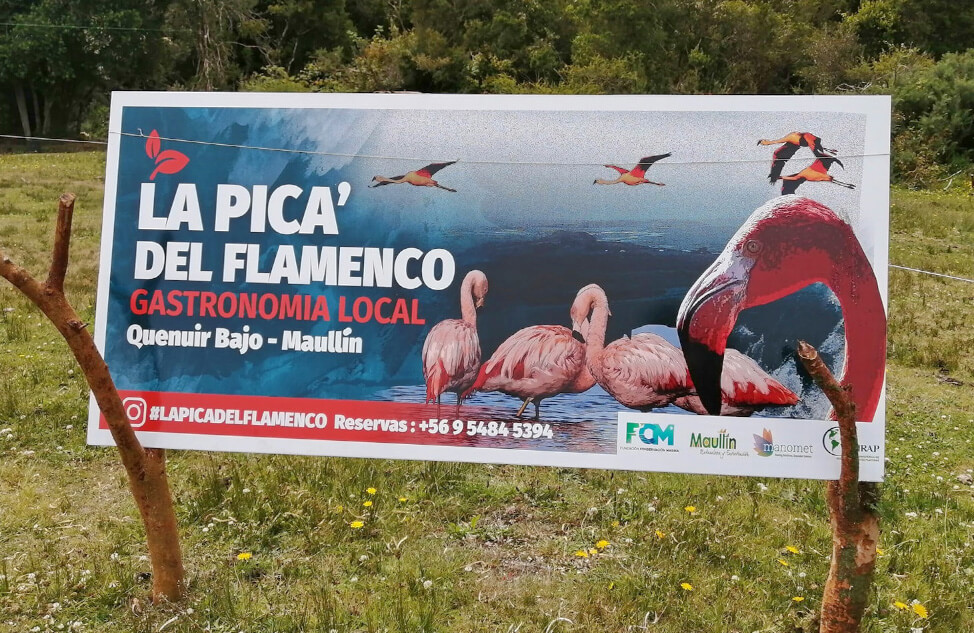
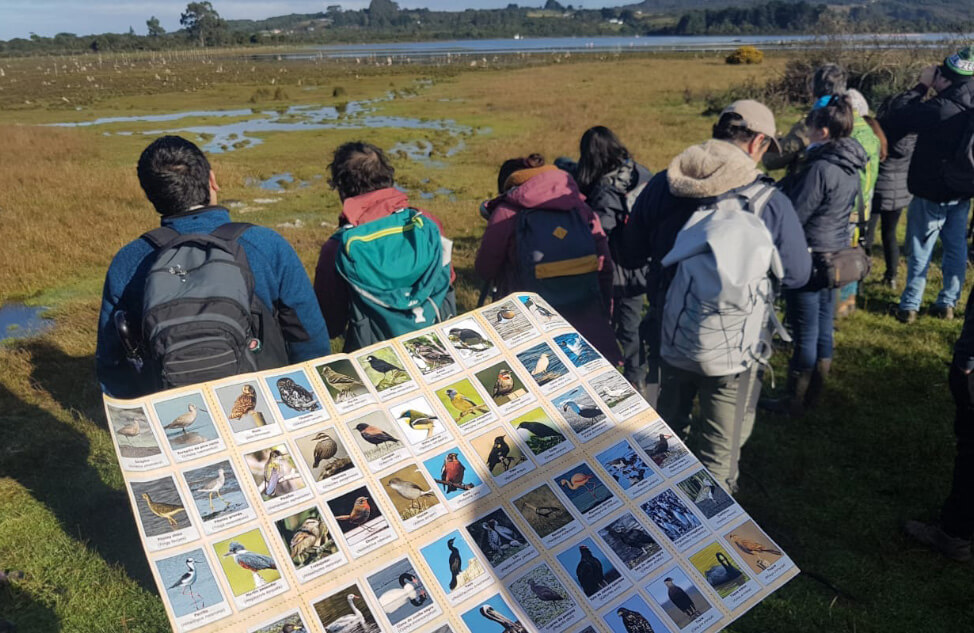
Left: La Picá del Flamenco, a food stall that is a must stop in the wetlands of Maullín. Photo: José Cárdenas Vejar. Right: Guided bird watching tours in Maullín are increasingly in demand by tourists. Photo: José Cárdenas Vejar.
A fundamental shift in awareness of the local feathered superstar testifies to the success of the initiative. “Back in 2014, neither residents nor visitors had heard of the Hudsonian Godwit, let alone its migratory feats,” Diego recalls. “Yet just five years later, three thousand people attended the Curaco de Vélez Feria de Aves, Artesanía y Turismo [Bird, Crafts and Tourism Festival]”. The event celebrates the area’s avian long-haul travellers. Tellingly, Hudsonian Godwits have even become part of the local brand, with their image advertising local empanadas (pie-like pastries). Claudio points to further favourable outcomes around key Chiloé wetlands. Tourists are now served by multiple dining, accommodation, and retail facilities as well as an ecotourism guide, while there is now municipal investment in birdwatching infrastructure and the local artisan shop serves as a mini-visitor center.
Buoyed by such clear successes on Chiloé, microfunding was extended to communities living around the nearby Humedales de Maullín. On the adjacent mainland, the Humedales de Maullín is a regionally important WHSRN Site, its wetlands serving 18 species of migratory shorebirds including 1% of the Hudsonian Godwit’s Pacific population.In 2019, Chile’s Council of Ministers for Sustainability approved the creation of a Nature Sanctuary of just over 8,000 hectares. Here too there is good news. The number of local ecotourism operators has leapt from one to twelve. Six local entrepreneurs have received grants, which they have been used to purchase optical equipment, produce merchandise, and equip a tour boat for birdwatchers to explore the wetlands. Microfunding enabled one family to realise their dream of satisfying the rumbling stomachs of the many birdwatchers with support to start their restaurant named ‘La Picá del Flamenco’ in honour of the Chilean Flamingoes (Phoenicopterus chilensis).
By weaving conservation into the fabric of the local economy, microfunding has created what Claudio calls “local shorebird conservation agents”. It now makes business sense for local entrepreneurs to protect the resource – shorebird-rich wetlands – that attracts their customers in the first place. Recipients of microfunding “understand that healthy habitats with lots of birds are now part of their business,” Diego says. By leading shoreline clean-ups, ensuring that dogs are kept on leashes, preventing vehicle access to sensitive habitats, and strengthening wider community involvement, Diego explains that businesses “have begun to take care of their own backyard”.

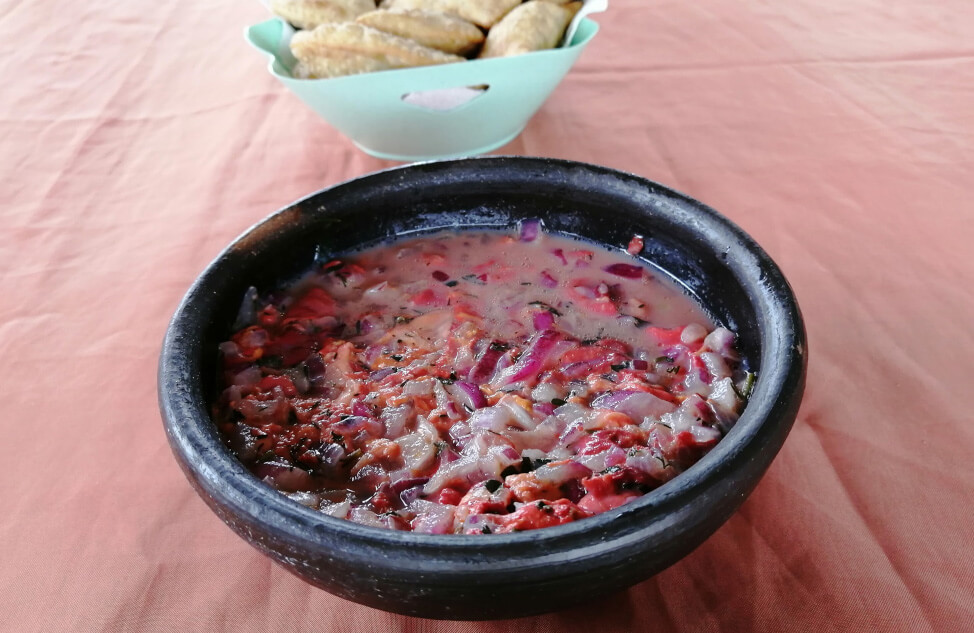
Left: Bird watching tours are part of the local tourist offer. Photo: José Cárdenas Vejar. Right: The traditional Mariscal in “La Picá del Flamenco”. Photo: José Cárdenas Vejar.
This is impressive stuff. But for those involved, the successes so far seem merely to represent the start. Both Claudio and Diego are keen to expand the resources for microfinancing – seeking to support more Chiloé and Maullín entrepreneurs with more grants. This is particularly important to help resuscitate ecotourism locally following the COVID-19 pandemic. Claudio further favours a strategic approach, coordinating beneficiaries of funding “to generate a joint action plan aimed at strengthening ecotourism as a tool for shorebird conservation”.
That microfunds are serving Chilean shorebirds suggests that this particular conservation tool could help other important conservation areas across the Americas. Although Claudio cautions that there is no one-size-fits-all solution – “every country, site, and community is different”. To succeed, Diego suggests, means taking time to build trust with local communities before gradually and transparently identifying their particular economic needs.
The young girl looking through a telescope at Las Lajas understands nothing of all this. She is simply delighting in the shorebirds’ long-billed legginess, savouring the local empanadas that her family buy for lunch, and looking forward to donning a life jacket before boarding the birdwatching boat. She and her family will be back. As will those Hudsonian Godwits. Where financing for conservation is concerned, small can certainly be beautiful.
Cover Photo: Hudsonian Godwits. Photo: Diego Luna Quevedo.






